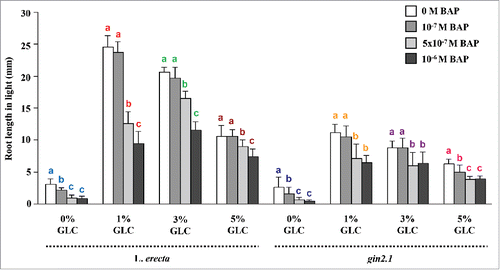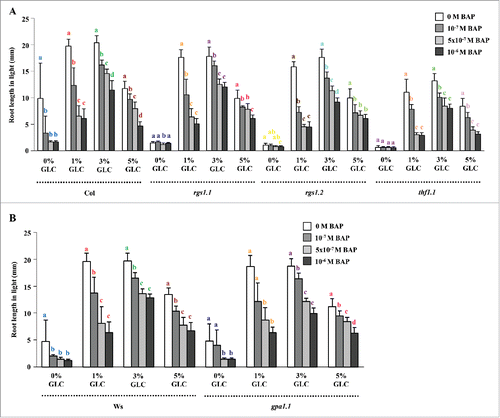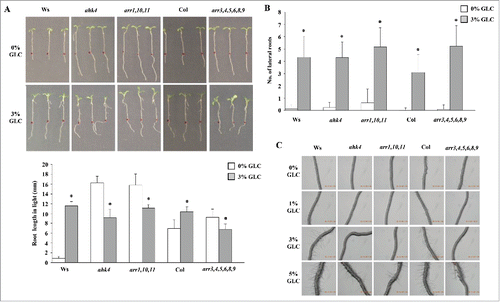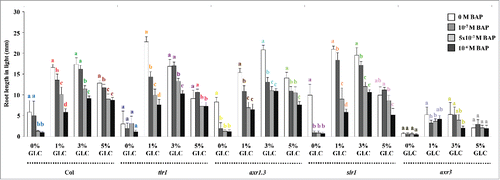Figures & data
Figure 1. GLC-CK signaling interaction in WT for root length control: BAP decreased the root length in Col at all the concentrations tested. GLC supplementation in the medium increased the root length. The increase in root length was found to be more at 1% GLC and 3% GLC, whereas found less at 5% GLC when compared with the untreated control. For controlling root length, GLC and CK work antagonistically at lower GLC concentrations but act agonistically at higher GLC concentration. Data shown is the average root length and error bars represent SD. Means accompanied by the different letters in a group at mentioned GLC concentration are statistically different (All Pairs, Tukey HSD post ANOVA test at P≤ 5%).

Figure 2. HXK1-dependence of CK signaling for root length control: Root growth of L. erecta and HXK1-dependent pathway mutant gin2.1. The gin2.1 mutant was found less sensitive at all the GLC concentrations tested to CK for root length control as compared with WT. Data shown is the average root length and error bars represent SD. Means accompanied by the different letters in a group at mentioned GLC concentration are statistically different (All Pairs, Tukey HSD post ANOVA test at P ≤ 5%).

Figure 3. Root length of HXK1-independent pathway mutants: (A and B) The HXK1-independent pathway mutants rgs1.1, rgs1.2, thf1.1 and gpa1.1 were found to have similar sensitivity to CK for root length control as compared with WT. Data shown is the average root length and error bars represent SD. Means accompanied by the different letters in a group at mentioned GLC concentration are statistically different (All Pairs, Tukey HSD post ANOVA test at P ≤ 5%).

Figure 4. CK signaling dependence of GLC response for root length, lateral root numbers and root hairs: (A) In CK-receptor mutant ahk4 and type B ARR triple mutant arr1,10,11, root length was found to be more even in the absence of GLC as compared with the WT. (B) CK perception mutant ahk4, type B ARR triple mutant arr1,10,11 and type A ARR mutant arr3,4,5,6,8,9 displayed similar lateral root numbers as compared with the WT. (C) The root hair initiation was defective in ahk4, arr1,10,11 and arr3,4,5,6,8,9 on increasing GLC concentration and lesser number of root hairs were visible even on 5% GLC as compared with WT. Data shown is the average root length/lateral root numbers and error bars represent SD. Student's t test, P < 0.05, *control vs treatment.

Figure 5. Involvement of auxin signaling downstream to both GLC and CK in controlling root growth: The auxin signaling mutants tir1, axr1.3 and slr1 were found to have similar sensitivity whereas, axr3 mutant was found highly resistant for different concentrations of GLC and CK for root length control as compared with the WT. Data shown is the average root length and error bars represent SD. Means accompanied by the different letters in a group at mentioned GLC concentration are statistically different (All Pairs, Tukey HSD post ANOVA test at P≤ 5%).

